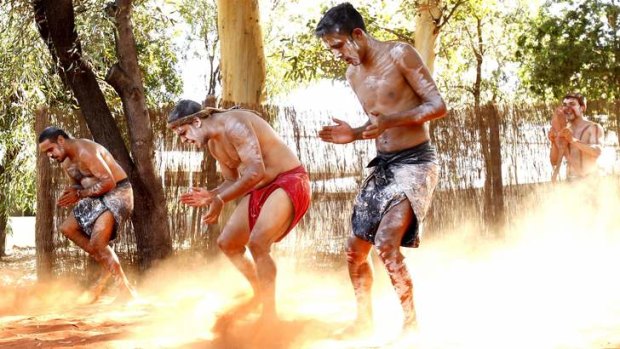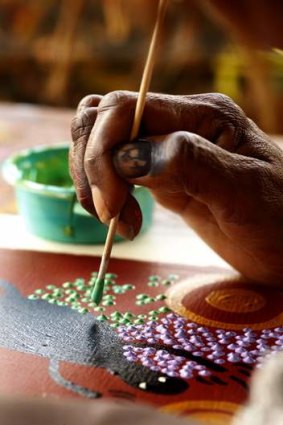
A performance by the Wakagetti dancers.Credit: Steven Siewert
Uluru is an education, writes Tracey Spicer.
It emerges, like a massive rustbucket, out of the desert sands but remarkably most of theworld’s largest monolith is underground – nearly five kilometres of it – with a mere 348 metres peeking out. Butwhat an impression it makes, even from the air. Passengers on the plane gasp, clap and cheer aswe descend intoAyersRock Airport.
In the traditional Anangu language, Uluru means “place to gather”, but manyAustralians have never visited this iconic attraction. And itwas on ground level, here for a five-night holiday, that I become aware ofmy own kids’ ignorance of indigenous culture during theWakagetti welcome dance. “Are theywearing nappies?” seven-year-old Grace asks innocently about the dancers’ loincloths.

Artist Rebecca Wheeler paints at Voyages Resort.Credit: Steven Siewert
Later, on the full-day Desert Awakenings tour, our guideNed makes a subtle suggestion: “See this?’’ he asks. ‘‘It’s called the Learning Tree.We used to put the sap fromthis tree in kids’ mouths so they’d shut up and listen.” Sell that in the city and you’d make a fortune.Of Aboriginal and Irish heritage,Ned left home at 14 to hitchhike acrossAustralia in search of his roots.
He’s a bit of amyth-buster: it’s only Aborigines fromsouth-east Queenslandwho have returning boomerangs. In any case, “If your boomerang kept coming back, you’d be bloody hungry, because it would mean it didn’t hit anything,” he laughs.
Andwhat’s more,Ned says, corroboree isn’t a “blue light disco”: the dancers re-enact catching kangaroos to pass on the knowledge to young men in the tribe. “You mean, teenagers?” eight-year-old son Taj asks.
“There are no teenagers in our culture,”Ned answers. “They go frombeing children to adults in an initiation ceremony, at some stage between the ages of 12 and 16.”
We’re staying at the top-end Sails in the Desert. It’s one of several accommodation properties near Uluru managed byVoyages Indigenous TourismAustralia, a subsidiary of the Indigenous Land Corporation. Profits are reinvested in training and development programs for indigenous communities.
As luxuriously comfortable as the accommodation is, Uluru’s looming presence dominates.Up close, the rock resembles red honeycomb, its sandstone surface pocked by 50 million years of exposure to the elements.Aknock elicits a hollowsound, due to rust created by iron oxide in the soil. It’s the perfect environment for a camel,whichwe learn in another lesson is the only animal that can store its urine, passing it through its kidneys to extractwater and keep the body hydrated.
During our hour-long ride through the rich red dunes, the lead cameleerSam keeps the kids entertained with stories such as that one. The Camel Express attraction at Uluru only accepts children over the age of five, because the loping motion can lull youngsters to sleep. It’s believed these beasts of burden transported the first piano across the outback.
“You could say theywere instrumental in this,”Samsays with a wry smile.
There’s nearly as much to do by night. The highlight of the famed Sounds of Silence experience is dinner under the stars, with an entree of kangaroo tail broth and a main course of lemonmyrtle chicken and quandong apple crumble.
“This is our kitchen,’’ saysNed, pointing to a rock on the ground.
‘‘You can grind any seed into a flour, addwater to create a paste, then turn it into damper.”
Travelling as nomads, “there was no room for argument, or people might starve”.
More than half the visitors to Uluru are from overseas, so it’s no surprise that the first question on our Family Astro Tour is, “Where’s the north star?” Instead, we learn how to navigate using the southern cross, which the indigenous people characterise as a stingray with two sharks chasing it. The following day, we learn another handy survival skill, in the form of Yiri.
“We’ve had a broken nose, busted chin, and smashed camera. So watch out,” our instructor, Jason, smiles. Yiri is a series of games aimed at improving kids’ accuracy in hunting. They practise by throwing tennis balls through a tyre suspended from a tree. Then the big guns are brought out: spears and boomerangs.
The good news is the boomerangs do come back; the bad news is they come back towards us at speed. Kids are scattering like tenpins, squealing with delight.
“The boomerang nearly chopped Taj’s head off,” Grace cackles.
Fortunately, no one is decapitated, and everyone walks away with a greater appreciation of the skill involved in traditional Aboriginal hunting.
After our sports lesson, it’s time for an art class. If Uluru is, as Ned suggests, the indigenous peoples’ church, then traditional dot paintings are passages from its Bible.
Each has a moral message. One of the 800 Anangu artists, Griselda, gives us a small canvas, wooden stick, and fine paintbrush, to depict a scene from our urban lives. “All the symbols are done from an aerial perspective,” our teacher, Ernest, explains. “Circles are locations, while the lines between them indicate travelling.
A‘u’ shape is someone sitting, while an ‘o’ is either a bowl or shield.”
I took the kids to Uluru to educate them about our indigenous culture. But it turns out their ‘‘take home’’ messages are so much more. Taj loved learning about geology and Grace, astronomy.
‘‘I loved learning how nature can create more awesome things than even technology can," says Taj while Grace ‘‘loved learning about the planets and stars, at night’’.
After five nights at Uluru (yes, there really is enough to do)we leave with a deep sense of patriotism and pride, after witnessing the warmth and wisdom of the indigenous people.
Really, every Australian, young and old, should come and see the nation’s true heart. T
The writer and her family travelled as guests of Voyages.
TRIP NOTES
STAYING THERE
Voyages Ayers Rock Resort offers holiday packages starting from $255 a person twin-share, including breakfast, for two nights, at its Emu Walk Apartments to $370 a person twin share, including breakfast, in the luxurious Sails in the Desert, refurbished in late 2012.
It features family-friendly, inter-connecting rooms and a large pool and lawns in the centre of the complex.
GETTING THERE
Jetstar and Virgin Australia operate flights to Ayers Rock Airport from Sydney and Melbourne. Qantas operates daily flights to Ayers Rock Airport via Alice Springs, while Virgin's Melbourne flights travel via Sydney. jetstar.com.au; virginaustralia.com.au; qantas.com
MORE INFORMATION
ayersrockresort.com.au
travelnt.com
Sign up for the Traveller Deals newsletter
Get exclusive travel deals delivered straight to your inbox. Sign up now.